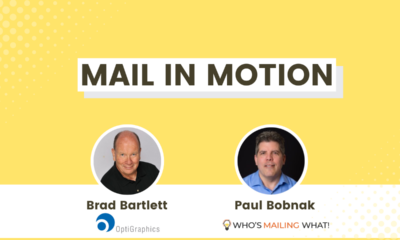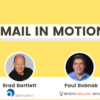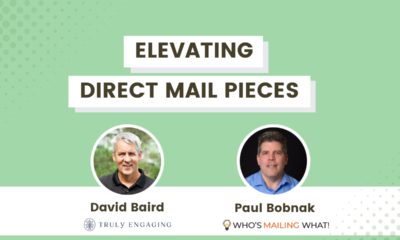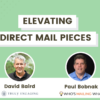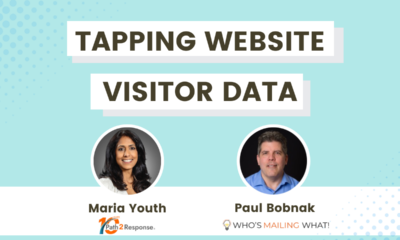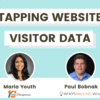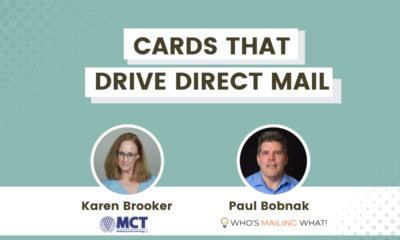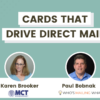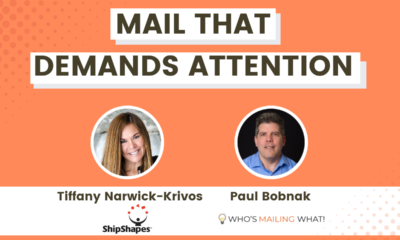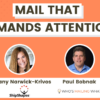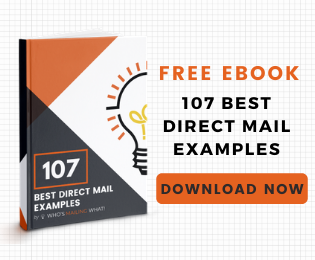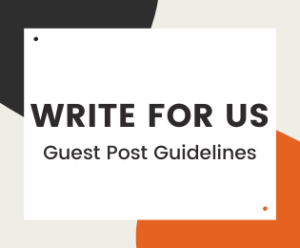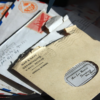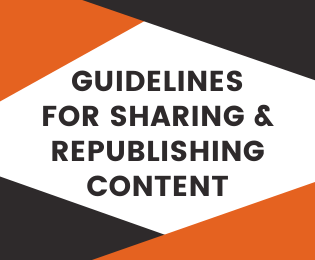MEET THE MAILERS
Meet the Mailers: Why Personalized Maps Enhance Direct Mail
In this episode, we talked with locr about how they work with marketers by using geodata to create relevant personalized maps and geo-information services for direct mail and print campaigns.
In this episode, I talked with Randy Hardy, North American Representative for locr. Headquartered in Braunschweig, Germany, locr is a leading provider of geomarketing services that let marketers use location to their advantage.
We chatted about how the company works with marketers by using geodata to create relevant, personalized maps and geo-information services for direct mail and print campaigns.
As Randy said:
What’s more personal to you other than spouse or significant other, children, and a pet? Where you live. And when you see the map and you see where you live, you can’t not look at it. Your eyes are drawn to it.
 Randy Hardy
Randy Hardy
North American Representative
locr
Among the topics we covered:
- Randy’s background in print and sales
- Advantages of using locr’s services
- Personalized maps can improve the ROI of direct mail campaigns
- Why its new product is a game-changer
- Trends in direct mail marketing
Here are some questions and answers from our conversation (edited for clarity and space):
- Let me just jump right into it and talk about locr and the power of location data. What are the advantages of locr’s products and services for marketers as well as for printers?
It’s actually getting even more and more valuable simply because one of the big things we do is saving money on postage, and gee, as USPS keeps climbing the scales, the ability to save people money with postage is obviously getting more and more important.
So there’s really three things that we do.
We do customer targeting. We can take a CSV list of recipients. And then we have another list of the destination or destinations. And we can calculate the actual driving distance in minutes or in distance (miles), and we can then take a look at that and the customer can give us rules.
We had one customer that ran for a very large campaign for a very long time, and their rule was “we want to show the six closest stores but none more than eight driving miles away.” If those are the rules, those are the rules. So we did that campaign – the net result: we became a negative cost to the job. We suppressed enough people that the savings in postage outweighed the cost of our services. So if you can get better results, while saving money – that’s kind of interesting for an ROI discussion.
And so that second part: acquiring the customers – I have a mail piece that I’ll show that we did from many years for AARP.
They want you to go to a safe drivers course, and so this started shortly after I started the US market, an ad agency was at an XMPie user group and I was presenting. Two months later, they called me up and said, “Hey, I think we could do something here”. We sure could – the net of it was they wanted to suppress people that were too far away. I mean, are you gonna drive 50 miles to take a safe driver’s course? I’m not. Initially, the only intent was to save some costs. First, we did a test of 10,000 pieces. Then we did a test of a quarter of a million. Then six, seven, eight hundred thousand records a month. By the end of the first year we’d processed about three million records. We had disqualified about half a million. Do the math: that’s an awful lot of money in postage and even some print, of course, that we save them.
And by the way, sometimes printers get a little intimidated that were suppressing print. “Randy, I’m trying to print more not less”. So this is very instructive on that because at the end of that year, as I said, they lost out on half a million prints. Except at the end of the year, they looked at the increase in response rate which was 70 – and that is seven zero – percent.
Even if I wasn’t saving money, they would have kept on doing this. This is on top of the money I’m saving them from that suppression. They’re not stupid people – they doubled the program the next year to six million records. And so maybe we suppress … I don’t know… a million, but that means the printer still got five million when he used to get three. So the power of ROI is the printer’s best friend because you don’t lose business when you’re making people money.
And we have one more piece that’s relatively new to us. We now have the ability to bridge the print world with the online world. So, really, three things: targeting, acquisition, and making accessible across electronic mediums.
- Why do maps work in geomarketing to increase response rates & ROI or otherwise make better marketing decisions?
Yeah, this one’s highly interesting. It was a couple years before I was able to get statistics because obviously from AARP, we could see it work. We gave them a map, people started showing up. They actually had a problem with too many people showing up sometimes, because they would rent hotel rooms for these classes and they make it for say, oh five or six, and all of a sudden 15 people showed up.
Pretty good problem to have too many responses. Yeah, but the key thing, and direct mailers are always talking about this, the more it’s personalized, the higher the response rates. So if you go back to the old spray-and-pray days, we’re basically name and address, and that was it. Maybe “Dear Sir”, right? Now with tools like XMPie and Quadient, you can get very sophisticated messaging obviously. And so this is it continuing that personalization. When you buy lists or have your own list and you do your data mining and so you’re looking at “What’s their income? Do they have children? What’s their education?” You could hit all of those attributes. But if they’re too far away, they’re still not coming. Yeah, “perfect customer” except, gee, “no thanks”. So you’re wasting all your money marketing to people that aren’t showing up.
The other thing though is that if it is relevant distance or time-wise, what’s more personal to you other than spouse or significant other, children, and a pet? Where you live. And when you see the map and you see where you live, you can’t not look at it. Your eyes are drawn to it.
And the other beauty …we got some information from MIT, which we’ve created a white paper “The Power of Maps.” And by the way you did a white paper for us on similar things before we had that data. MIT has calculated that an infographic – so it’s not just a map – but of course in printing we understand that – infographics are images that convey information. By definition, a map is one of those infographics. A)your eyes [are] drawn to it, plain and simple, and B) it takes your brain less than a quarter of a second to get the message. Because we’ve been looking at images for millions of years, haven’t we, meaning pictures? So our brains are not supersized for text. They are supersized for looking at something.
The best example of that is I have a PowerPoint that I give where I bring up just an address and text of an address in DC. I ask everybody, “Do you know where that is?” They say it must be Pennsylvania Avenue. And I say, “no – you can see the address is not Pennsylvania Avenue.” So then I click and a map comes up showing that it’s literally next to the Capitol Building, and everybody goes “I know where that is”. So us humans need context, not data. It’s the same information, but now we’re portraying the information instead of telling you the data.
- Getting to something you talked about before which is one big concern of marketers today is the cost of mailing campaigns. How does using maps like locr does help lower costs?
So there’s two parts of that. One part of it is about lowering the cost. So in that campaign, I was saying before, about close to six but no more than eight driving miles, right? So, the printer was actually the first time the job came to me. He just gave me the data and said “Make the maps.” I just thought it was a one-off job, I made maps. Six weeks later it came back again. I go “Oh, cool” and then again …on the third job I said “Wait a minute, who’s doing all this targeting?” “Oh I’ve got that covered and I’ve got all these hardcore programmers. I’ve got XMPie and Quadient. I can do all that.” I said “No you can’t – you don’t have the mine tools.” The smartest guys in the world are still constrained by the type of tools they’re using. What I was referring to, of course, was that he was doing straight-line calculations. And I’m doing the actual driving distance.
The best example of that is I live on the North Shore of Long Island and I get mail pieces asking me to go to Connecticut six miles away. Yeah, but I don’t feel like getting wet. It’s 100 miles to go out and around on the bridges or I’ve got to spend an awful lot of money to go 10 miles to get a ferry, and so those marketers – because I get them all the time – are completely wasting their money marketing to me, when I’m not even remotely close to these people. That’s the power of location at work.
Another sample I’ve got, Paul. This was only 2500 mail pieces. You can see we got the map on the front which was smart because that draws your attention. In the back here’s a tipped-on plastic card for ten dollars off.
In my business, one of the obstacles of using my technology is the cost per piece. And on small qualities, the cost per piece goes up because you’ve got set-up fees and things like that. Just like make-ready on a press, and sometimes a smaller project, it’s not always easy to justify. And upfront, this one wasn’t, but this printer out of Tulsa was able to make the sale for us with his customer, and at the back end, 2500 of these now with that tipped-on card and my map, and it’s actually a three-pane foldover. This is not a cheap little piece, especially for 2500. What, a buck a piece?
Yeah, I don’t think he really cared about how much the mail piece cost when he had a 24% redemption rate. 600 of these things were cashed in. You mail something properly using all the correct tools – both data and visual – and guess what? Mailing is cheap, not expensive. So that’s one of the ways that you can employ technology and the data to be more precise about who you’re marketing to.
- So, how exactly does implementing geomarketing work? Can you take us through the basic process to generate a map and put it on a direct mail piece?
What we do is really complex. Fortunately, we’ve made it really easy for you to do…I’m a business person not a technical guy like my guys back in Germany. They’re brilliant. I don’t know how they do it, but they do. So, the simple thing is that all you need to do is give us a CSV list of your recipients. After CASS and NCOA, of course, we don’t want to be mailing to where they were, or making a map and they get a map that doesn’t match the address there.
Then you need a CSV list of the destinations or destination – sometimes it’s just going to one place – but if there’s multiples you give me those and then if there are rules, like the rule might be just “I just want the closest one.” Fine, we do that. But again, as I mentioned before, they can be far more complex. We did a project for the Canadian Automobile Association. They gave us 10 groups of data. And we had to pick the closest from the first group, which was your local CAA Office. Then the closest from the next one, which was a bunch of vendors. And all the way down. What was really interesting is that they were charging people to be on the map. They were making money by the time they put it in the mail.
Everyone, of course, is infatuated with Google Maps, and 99.9% of the time, they should be. It’s just amazing technology, especially for all the things we want to find out around us and whatnot. The one area they’re not really strong – gee – is in the print world.
And certainly not because they can’t be – they’ve got brilliant people. They don’t care to be. The print market for maps is just not strong enough for them to care. And so the beauty is we can do things they can’t.
So first of all, when you get a map from Google, you tell them what you want. “I want to go from here to there” and they take all the elements and they slap it on top of the digital map of the world. There you go. That’s all you need. Well, in our world it’s a little bit more complex than that.
So you can think of us as a composition tool for geo data. We take raw data, and then we take what you’re interested in. And then we actually draw every single map from scratch and so we can do things like the street name is cut in half at the edge. We actually move the street name over. Or if there’s no room to move it over, we delete it because half a name is more confusing than no name.
If there’s going to be pins on top of each other – if it’s multiple destinations, right? In the case of CAA, if you were paying to be on that map, would you be happy if I put somebody else’s marker on top of yours? No. Of course, in the Google world, of course, that works online. Our medium doesn’t work so much.
So there’s lots of ugly things that we do just like any other business does for their customers, but we’ve really honed it for print and direct mail very specifically. The last part of it is once you give us those lists, we do all the work. We send you back the maps and/or data. All you’ve got to do is pull down the images, the CSV list that you sent us, if you want extra data, we just append that list.
Another important element, because this is very important when we do a lot of healthcare mailings, is that when you send us the list, we require that you give us a unique ID for every record. Now it can be as simple as, if it’s 10,000 recipients, it’s number one to 10,000. We don’t care, just has to be unique not repeated. What’s critical for the end user to understand though, is that that’s what we use to identify the record, not first name last name. Many of our healthcare customers delete their first-name and last names from the records they send us. Now they’re sending us anonymized data, not PII, so even if we got hacked, it’s just a bunch of addresses with a unique ID. That keeps it more secure.
- Recently, you’ve introduced locrFINDER, a location finder that can be incorporated with a print campaign, like direct mail. Can you talk about how it works and why it’s a game-changer in a lot of ways?
Yeah, thank you! We introduced it at Printing United. And so, let’s call it four ways to use our locrFINDER. The simplest one is that there’s a QR code next to the map. The user scans a QR code, and it automatically activates the phone GPS and shows them how to get there so they don’t have to type everything into their phone. That’s certainly useful.
But then there’s a couple other ways to utilize it. The next one is more interesting. We actually just went live with a program with the first implementation in the U.S. and that one is for a healthcare system. So when you get a map and it shows you I think the closest two, but none more than 10 miles, for the print version. But when you scan the QR code, they expand the area of what they might offer you locations. Because it’s one part that you and I both understand about direct mail and not everybody else does: you’re almost always mailing to their house, that’s not necessarily where they want to consume our service.
And so on the online version…you can give greater options. “I got a place a quarter mile from my office.” Bing! You’ve got a customer that you would not have had – perhaps – if it was showing just from the home. And we can even do things like multiple logos and services. So in the healthcare [example], we can show the house, then one logo for the PCP, another logo for walk-in clinic, and another logo for hospital. [I]n the finder app, you can just touch one of those and immediately it shows you how to get there. Touch another one, it shows you how to get there. All that searching activity typically would be consumed by all the search engines and sold. And the healthcare people aren’t real happy with that idea.
That’s another beauty of having the servers in Germany. Europe a few years ago came up with something called General Data Protection Rules (GDPR). Germany is even more stringent on the data privacy rules. The simple answer is that it’s illegal for us to sell that search data. However, we can give it back to who gave us that data for free.
And so that can be highly useful because maybe you see somebody was searching, but didn’t actually click through because maybe they didn’t have a broken leg that day. Now they know where they can go for care when they do have a broken leg or whatever the case may be. The hospital system can see these people that actually scan the QR code, obviously showing a higher level of Interest than people that didn’t respond at all, right? So you actually get a better handle of what the open rate was from getting this data from the QR code. That can be very very powerful. There’s a bunch of different reports that we can create showing … visits by day – visits by hour – visits by their postal code, so you can see a heat map about where they’re hitting, and then you can export that information including a picture or CSV file if you wanted, on this data. As you go further in time, we’ll give you better reports.
One more usage which we haven’t really gotten to yet, but I think could be a very big one, and that would be EDDM (Every Door Direct Mail).
And the beauty is of course, that’s very cheap. That’s why people do it. They don’t want to pay for personalization and all and the extra postage because of course, the post office gives them a discount on their unaddressed mail as well.
But one beauty of our locrFINDER is that you could create one QR code that you print for all those EDDM pieces. And now you have a personalized EDDM campaign. Because the QR code, when it scans, senses where the phone is.
- So talking about direct mail in general, what trends do you see happening in the next year, couple years?
Yeah, so there’s a couple things. One, I kind of touched on this in the beginning with USPS aggressively raising rates. They are so misdirected there. I’m not trying to be rude, but they think if we raise the cost then we’ll offset our losses. Yeah, except people use your product less, so then you actually lose more money.
And so sadly this will probably be good for my business because that makes every single mail piece even more precious. Meaning you need to be far more efficient in your targeting and your mailing campaign so that you can maintain that ROI even with that high cost of delivery. So if you’re getting a 24% response rate, you could probably keep getting even with the added cost, you’re gonna keep doing those campaigns.
But there’s another piece, especially with my German friends. They’re a little bit more on the forefront of this, although there’s certainly lots of U.S. companies doing this as well. And that’s sustainability. Why are you sending out mail pieces that you know no one’s gonna even look at?
So both from a pure cost standpoint – ROI – but also from a sustainability perspective. Hey! Only mail to people that this is actually relevant to, and we can help do that.
Here is our conversation (with all questions and answers). We’ve added timecodes for your convenience.
Thank you very much, Randy, for sharing your perspective and your expertise! To learn more about locr, visit their website at www.locr.com.
Your comments and ideas are very important to us in making your Who’s Mailing What! experience even better for you. Through these engaging talks, we hope you’ll take away practical tips, insights, and personal stories to inspire and build your own success.
If you have any feedback — or are interested in sharing your expertise and viewpoint with our wide and diverse audience on “Meet the Mailers” — please reach out to me. I’d love to hear from you!







